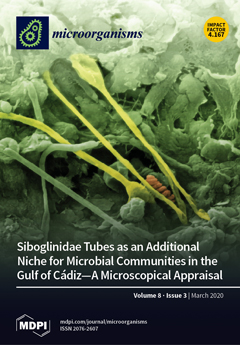The role of bats in the enzootic cycle of Lyme disease and relapsing fever-causing bacteria is a matter of speculation. In Canada,
Borrelia burgdorferi sensu stricto (ss) is the genospecies that is responsible for most cases of Lyme disease in humans. In this study, we determined if big brown bats,
Eptesicus fuscus, have been exposed to spirochetes from the genus
Borrelia. We collected serum from 31 bats and tested them for the presence of anti-
Borrelia burgdorferi antibodies using a commercial enzyme-linked immunosorbent assay (ELISA). We detected cross-reactive antibodies to
Borrelia spp. in 14 of 31 bats. We confirmed the ELISA data using a commercial immunoblot assay. Pooled sera from ELISA-positive bats also cross-reacted with
Borrelia antigens coated on the immunoblot strips, whereas pooled sera from ELISA-negative bats did not bind to
Borrelia spp. antigens. Furthermore, to identify if bat ectoparasites, such as mites, can carry
Borrelia spp., we analyzed DNA from 142 bat ectoparasites that were collected between 2003 and 2019. We detected DNA for the
Borrelia burgdorferi flaB gene in one bat mite,
Spinturnix americanus. The low detection rate of
Borrelia burgdorferi DNA in bat ectoparasites suggests that bats are not reservoirs of this bacterium. Data from this study also raises intriguing questions about
Borrelia infections in bats, including the role of humoral immunity and the ability of bats to be infected with
Borrelia burgdorferi. This study can lead to more sampling efforts and controlled laboratory studies to identify if bats can be infected with
Borrelia burgdorferi and the role of bat ectoparasites, such as
S. americanus, in the transmission of this spirochete. Furthermore, we outlined reagents that can be used to adapt ELISA kits and immunoblot strips for use with bat sera.
Full article






